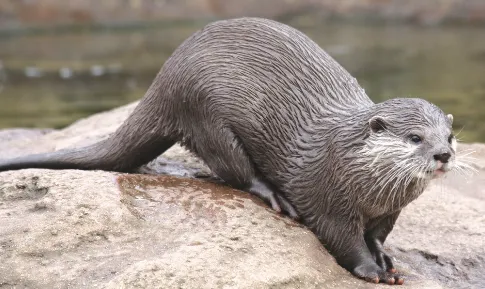Srinagar, Jun 9: In a rare and encouraging sighting, the Eurasian otter ñ long believed to be extinct in Jammu and Kashmir – has been spotted in a tributary of the Lidder River near Srigufwara in south Kashmirís Bijbehara area, renewing hope for the regionís fragile freshwater ecosystems.
Locally known as Wuddar, the Eurasian otter (Lutra lutra) is a semi-aquatic mammal classified as “near threatened” by the International Union for Conservation of Nature (IUCN) due to habitat loss, pollution, and illegal hunting.
“This is a very encouraging sign. We have installed cameras to document its presence,” said Suhail Ahmad Wagay, Wildlife Warden, South Kashmir. “Otters are apex predators in freshwater ecosystems and serve as critical indicators of ecological health. Their presence suggests the aquatic habitat remains relatively intact and supports a viable fish population.”
The Eurasian otter feeds mainly on fish and other aquatic fauna and typically inhabits clean, well-vegetated riverbanks where it builds dens known as holts.
However, these habitats are increasingly threatened by pollution, unregulated construction, and destructive fishing practices.
“Otters are completely harmless to humans and should not cause alarm,” Wagay said. “However, destructive fishing methods, such as the use of chemicals or electric shocks, are major threats and must be curbed immediately.”
The recent discovery is not an isolated case.
Over the past year, otter activity has also been reported in the Chenab River, the Rambiara stream in Shopian, and the glacier-fed Gurez Valley in north Kashmir’s Bandipora district.
Wildlife officials confirmed the species’ presence after it was captured on camera traps during a joint survey conducted by the Jammu and Kashmir Wildlife Protection Department and the Wildlife Trust of India (WTI).
It marks the first confirmed photographic evidence of the species in the region in more than three decades.
Despite their ecological importance, otters have historically been viewed as a nuisance by local fishermen — particularly in commercial fishing zones like Wular, Dal, and Manasbal lakes – due to their predation on fish.
This perception, combined with habitat degradation, is believed to have contributed to their disappearance from many lowland aquatic systems.
“From 2010 to 2019, we had only indirect evidence like fish remains, but no photographic proof,” said Suhail Intesar, a wildlife researcher and warden with the Department of Wildlife Protection. “The otter survived in remote glacier-fed streams where trout are abundant and human interference is minimal.”
Historically, Eurasian otters inhabited the backwaters of Dal Lake, the Hirpora Wildlife Sanctuary in Shopian, Dachigam National Park near Srinagar, and the Aru Wildlife Sanctuary in Pahalgam.
But sightings became increasingly rare due to mounting environmental pressures.
Once extensively hunted for its thick, waterproof fur, the Eurasian otter has seen dramatic population declines across much of Asia. In India, the species is protected under Schedule II of the Wildlife Protection Act of 1972.
Conservationists are now calling for immediate steps to restore natural habitats and implement long-term monitoring programs.
“Spotting otters in Kashmir again is a sign that nature is healing,” Wagay said. “But we must not become complacent. There is an urgent need to balance human activity with conservation goals to protect this vital species.”
The Eurasian otter is native to Europe, much of Asia, and parts of North Africa. While the species has rebounded in parts of Western Europe due to sustained conservation efforts, populations in South Asia remain scattered and highly vulnerable.
The post Otterly Unexpected appeared first on Greater Kashmir.








